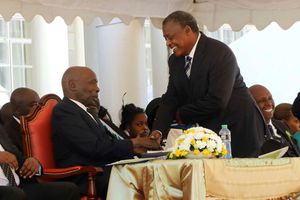Premium
Four years after Solai Dam tragedy, justice is still elusive for victims
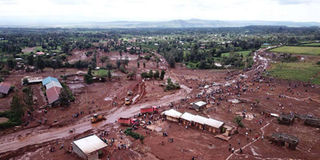
The aftermath of the Solai dam tragedy. PHOTO | FILE | NATION MEDIA GROUP
It has been four years since the Solai Dam burst, killing 48 people and displacing hundreds, yet justice still remains elusive for survivors.
Even as they struggle to recover from the May 8 tragedy that left an indelible mark on their lives, the event still haunts them.
The private dam, located on Patel Farm, which is owned and managed by Perry Mansukh Kansagara and Vinoj Jaya Kumar, burst its banks, washing away the surrounding villages of Energy, Nyakinyua, Endao, Milmet and Arutani.
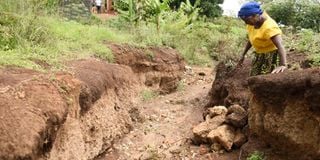
Thabitha Njambi struggles to walk across the rocky land with gullies at Solai in Nakuru County on May 7, 2021. She is one of the 2018 Solai Dam tragedy victims.
The floodwaters and tumbling debris hit Energy at high speed, washing away homes, cars and huge rocks towards the other villages downstream in pitch darkness.
Four years later, survivors are still fighting for justice court. Though they are picking up pieces, they still bear the scars and painful memories of the tragedy.
On Sunday, when they were meant to mark the fourth anniversary of the tragedy, all was quiet in the area.
There was no ceremony organised by either Nakuru County or the national government in memory of the 48 people who lost their lives. It passed like any other normal day.
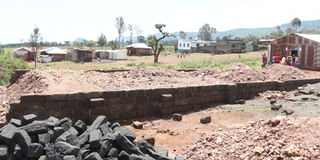
Solai in 2022, four years after teh Dam tragedy
In an exclusive interview with Nation.Africa, Mr John Mwangi, a 62-year old retired teacher who lost his wife in the tragedy, said survivors still bear the wounds and memories of the disaster, even as they slowly pick up pieces and rebuild their lives.
Mr Mwangi vividly remembers how the raging waters caught him at the doorstep of his shop, and tossed him around like debris before depositing him at one corner of the premises.
But he bears a bigger wound in his heart and soul.
He says that even after the tragedy, victims are yet to get justice.
“I survived by the grace of God and I thank God for a second chance. I lost my wife in the tragedy and my life has become a nightmare. I loved her and she made me happy. Did she have to die?” he said.
"We are yet to get any compensation; we have cases in court which have been dragging on since 2018. We hope one day we will get justice."
Although the affected Solai villages are slowly rebuilding, the sight of gullies, bare earth and desolation left after the Patel Dam broke its banks is still a reminder of the dark night of May 8, 2018.
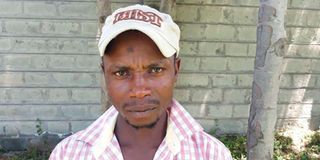
Mr Joseph Gathogo, a victim of the 2018 Solai dam tragegy in Nakuru County.
James Karanja, 39, another survivor who lost an uncle in the disaster, prefers not to talk about it, either.
“It is a day I never want to recall. In just one swoop, tens of people including my uncle lost their lives. We have tried to move on, but the bitter memories still linger,” said Mr Karanja.
Another victim, Naomi Nyambura, who lost her husband, yesterday told the Nation that his life changed after the tragedy.
“My life became a nightmare. I normally feel the emptiness whenever I visit his grave, but just seeing the children we brought up together, who are now grown-ups, gives me consolation,” Ms Nyambura said.
That is the story of many other survivors who now have their hopes pinned on courts, where they have filed cases to seek justice after the tragedy that they believe was as a result of human error, impunity by the dam owner and negligence by state agencies.
The survivors now seem to have turned to courts as their only solace, even as questions linger on whether it was an act of God or human error.
Dr Peter Mbae, the Kabazi ward representative, was the first to move to court a month after the calamity.
Dr Mbae sued the National Environment Management Authority (Nema), the National Water Conservation and Pipeline Corporation, Tindress Patel Coffee Estates and Salt Manufacturers Company.
He sought orders to compel Nema to conduct an environmental impact assessment of the seven remaining dams on the farm.
He also wanted the dam owner compelled to restore the ecosystem on his farm after the assessment.
Four years later, the case in which the owner of the dam and eight others have been sued for neglect, is still pending in a Naivasha court.
Witnesses have given evidence and the court recently visited Solai, the scene of the tragedy.

A view of Solai four years after the dam broke its bank and swept almost the entire village, killing more than 40 people. The land here remains bare with minimal agricultural activities on 8th May 2022
On the other hand, over 300 victims of the tragedy are seeking compensation for their losses in the Nakuru law courts, where they have filed a suit.
This case continued last week before Judge Joel Ngugi with the first witness, George Kegoro, who was executive director of Kenya Human Rights Commission, taking the witness stand. The court is set to visit Solai next month.
“The incident was the most difficult experience in my life. As the ward representative of the affected villages, it has caused me real emotional, psychological and financial distress over the years in search of justice for the victims, including trying dialogue and alternative dispute resolution mechanisms,” Dr Mbae said.
Exposed huge rocks, half-standing buildings and gullies dominate what was once a carpet of fertile topsoil where locals practised farming.
The landscape in the area still bears the scars of destruction the deluge left in its wake.
Although villagers are slowly healing, a visitor is still welcomed by deep gullies that dot the area, a grim reminder of the deadly waters that swept through.
Among the affected villages were those in the farmlands of Nyakinyua, where hundreds of people were displaced.
All the productive soil in a stretch of at least 15 kilometres was swept away.
Residents yesterday pleaded to the county government to help them recover the productive topsoil so that they can resume farming activities.
“We call upon the county government to intervene and help us obtain productive soil, so that we can continue with our agricultural activities. All the top fertile soil was swept away, leaving behind rocks and infertile soil,” said Ms Grace Kariuki.
The Solai shopping centre that was greatly affected by the tragedy is slowly beaming back to life, as a number of businesses that had closed down have reopened.
The Kenya Red Cross and a local church constructed 37 permanent and semi-permanent houses for survivors, including people who either rented out or occupied their houses, tenants and business people whose premises were partially or completely destroyed.
The houses, built for Sh40 million, were completed and handed over months after the tragedy.
The Kenya Red Cross partnered with Nakuru County to help survivors rebuild their lives.
Nevertheless, the infrastructural damage left behind by the tragedy is glaringly visible.
Mobile communication company Safaricom helped reconstruct the school that was the most affected and is actively involved in the restoration process.
Kenya Power and other organisations have also intervened to restore water and electricity supply in the region.
The raging waters destroyed electricity lines and water pipes as it swept everything in its way downstream. At least 1,302 residents from Solai Nyakinyua and 1,100 others from Akuisi farms last year received title deeds issued by President Uhuru Kenyatta.
Following the tragedy there were revelations that the Patels owned and managed nearly eight private dams without the required permits and accountability to the public.
The dams were stocked with water from blocked rivers. From families who lost their loved ones to those that lost property, what is now left are smidgeons of once complete villages.
Former Subukia MP Koigi wa Wamwere had in 1980 raised in Parliament the issue of the Patel coffee estates farm blocking rivers and streams but no action was taken.
Fast-forward to 2022 and nothing much has changed in the Solai and Rongai areas in general.
Impunity still reigns.
Illegal diversion of natural water sources in the areas is normal.
Large-scale flower farmers, especially in the Rongai area, still illegally channel water from rivers to their farms.
For instance, in January this year residents of Rongai protested the blocking of a key river by a private flower firm.
They accused the farm’s management of diverting water from the Rongai river during the dry season, leaving the people living downstream in Rongai and Mogotio without water.
Several other flower farms and large-scale farms still block rivers for irrigation, exploiting the ineptitude of enforcement agencies.




